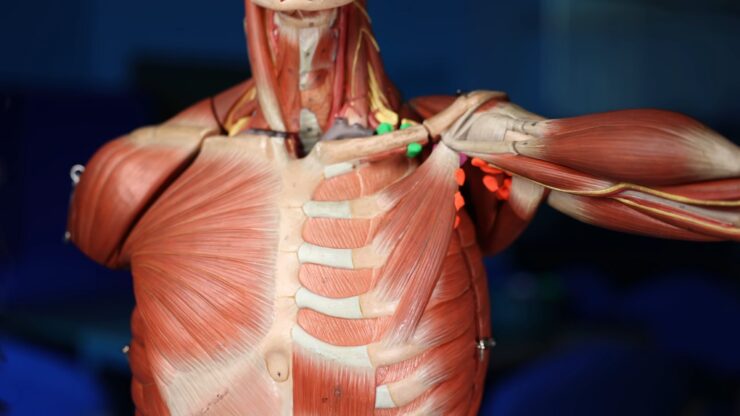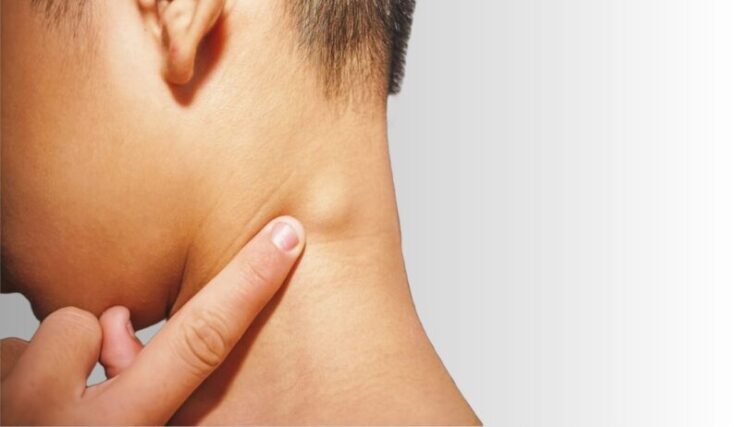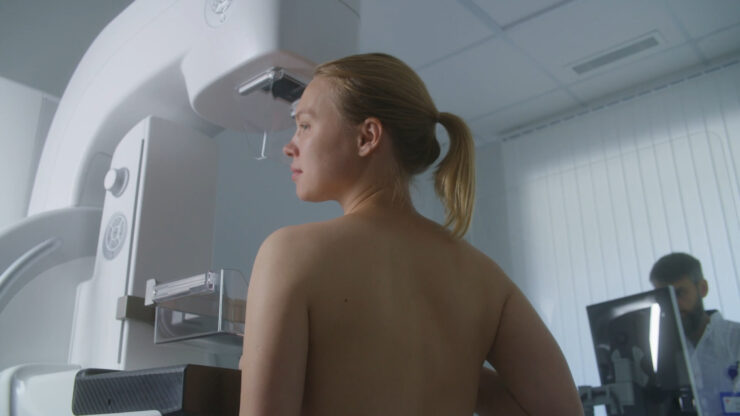Underarm pain, ranging from mild annoyance to severe discomfort, affects daily activities and may signal underlying health issues. While the pain’s intensity and duration can vary, identifying its cause is crucial for effective treatment.
This article will look into the anatomy of the underarm, the conditions that can cause pain, and potential treatment options.
Key takeaways
- Common causes of underarm pain include muscle strain, axillary abscess, lymphadenopathy, and conditions related to breast health, such as mastitis, cysts, or cancer.
- Prevention involves practicing good hygiene, avoiding overuse of underarm muscles, and addressing any infections or inflammations promptly.
- Underarm pain affects both men and women and can be exacerbated by lifestyle factors like poor posture, repetitive motions, obesity, and smoking.
- Seek medical evaluation for persistent or severe underarm pain to rule out serious conditions and ensure appropriate treatment.
Anatomy of the Underarm
The underarm, or axilla, is a complex region containing various structures, including muscles, nerves, blood vessels, and lymph nodes. These structures work together to facilitate arm movement and play a crucial role in the body’s immune response.
Any disruption or damage to these structures can result in underarm pain.
The most prominent muscles in this area are the pectoralis major and minor, which are involved in arm movement. The brachial plexus, a network of nerves that controls sensation and movement in the arm and hand, also runs through the underarm.
Damage or strain to these muscles or nerves can lead to pain. This body part also contains a significant number of lymph nodes, which are part of the body’s immune system. These nodes filter lymph fluid, trapping bacteria, viruses, and other harmful substances. When these nodes become swollen or infected, it can result in pain.
What can be the causes of underarm pain?
Muscle Strain and Overuse
One of the most common causes of axillar pain. Muscle strain can occur from heavy lifting, repetitive arm movements, or strenuous physical activity. The discomfort may appear when the muscles in this area are overworked or stretched beyond their limit.
Activities that can contribute to muscle strain include sports that involve throwing or swinging, such as baseball or tennis, as well as weightlifting.
Bench pressing is one of the activities that can cause axillar pain as well as perceptible flaws in the axillary region, according to the study.
Even everyday activities, like carrying heavy bags or gardening, can strain the underarm muscles if done excessively or without proper form.
If muscle strain is the cause of the pain, rest, ice, and over-the-counter pain relievers can help alleviate the discomfort. But, if the spasm persists or is severe, it’s important to seek medical attention to rule out more serious injuries, such as a muscle tear.
Axillary Abscess
It is a pocket of pus that forms in the underarm due to a bacterial infection. This can cause significant aches, along with other symptoms like redness, swelling, and fever. Axillary abscesses can occur as a result of a minor skin infection, an infected sweat gland, or an infected hair follicle.
The treatment for an axillary abscess typically involves draining the pus and taking antibiotics to clear the infection. In some cases, surgery may be required. If left untreated, an axillary abscess can lead to serious complications, such as the spread of the infection to the bloodstream.
The research reports: a 62-year-old woman experienced an axillary abscess complicated by venous thrombosis due to Streptococcus pyogenes. The patient was admitted to the hospital due to a history of fever, chills, nausea, and left axillary pain. Fortunately, she recovered completely after three weeks of therapy. Yet, this is your warning not to ignore axillary pain.
Lymphadenopathy
Lymphadenopathy, or swollen lymph nodes, is another common cause of the ache. The lymph nodes in the underarm can become enlarged due to various conditions, ranging from minor infections to serious diseases like cancer.
Common causes of lymphadenopathy include viral or bacterial infections, autoimmune diseases, and certain types of cancer, including breast cancer and lymphoma. Plus, swollen lymph nodes can also cause symptoms like fever, night sweats, and unexplained weight loss.
If you notice a lump or swelling in your underarm that lasts for more than a few weeks, or is accompanied by other concerning symptoms, it’s important to seek medical attention. Your healthcare provider can perform tests to determine the cause of the swelling and recommend appropriate treatment.
Did you know? Cervical lymph nodes and axillary nodes are atypical if > 1 cm
Breast-Related Causes
The underarm area is intricately connected to the breast tissue, and as a result, the ache can sometimes be attributed to breast-related causes. While this is more prevalent in women, it can also occur in men.
Mastitis
It is a breast infection. Mastitis can cause inflammation, discomfort, and even rash in the breast tissue, leading to pain that radiates to the underarm area. In addition to the ache, individuals with mastitis may experience breast tenderness, redness, warmth, and swelling. Fever and flu-like symptoms may also be present.
Did you know? Mastitis is most common during the second and third weeks postpartum, with 75 to 95% of cases occurring before the infant is three months old.
Breast cysts
These are fluid-filled sacs that can develop within the breast tissue, and their presence can contribute to discomfort that extends to the underarm area. Breast cysts may cause:
- localized pain
- breast lumps that are typically round and movable
- breast swelling or tenderness that can radiate to the underarm.
According to research, 7% of American women will experience a palpable breast cyst.
Breast cancer
It’s important to note that while breast-related causes of these spasms are usually benign, it’s crucial to rule out the possibility of breast cancer. Yes it is rare, but breast cancer can manifest with underarm pain as one of its symptoms.
Other accompanying signs may include:
- breast lumps
- nipple discharge (especially bloody or clear fluid)
- skin changes on the breast (such as dimpling, redness, or scaling)
- breast swelling.
It’s important to consult a doctor if any concerning breast changes or persistent underarm pain is experienced. There were 239,612 new cases of breast cancer in women reported in the US in 2020.
Regular breast self-examinations, clinical breast exams, and mammograms can aid in the early detection of breast-related conditions. Remember, only a qualified healthcare professional can provide an accurate diagnosis based on individual symptoms, medical history, and additional diagnostic tests if needed.
Infections and Inflammation
Underarm pain can be caused by various types of infections and inflammation, which can result in discomfort and tenderness in the area. Common examples include skin infections like cellulitis or folliculitis, as well as a chronic inflammatory condition known as hidradenitis suppurativa.
Cellulitis
It is a bacterial skin infection that can affect the area, leading to pain, redness, and swelling. The infection typically occurs when bacteria enter the skin through a cut, wound, or insect bite. Prompt medical treatment is necessary for cellulitis to prevent the spread of infection and potential complications.
Antibiotics are often prescribed to combat the bacterial infection and reduce inflammation.
According to the sources, cellulitis in the setting of lymphedema can present with axillary pain and rash.
Folliculitis
Folliculitis is another form of infection and inflammation that occurs when hair follicles become inflamed. This condition is commonly caused by shaving, waxing, or other forms of hair removal that irritate the hair follicles. Given how often we shave our underarm pits, it makes sense that folliculitis frequently develops there, resulting in painful and inflamed skin.
It presents as small, red bumps or pustules around the hair follicles, accompanied by itching or tenderness. Gentle cleansing, warm compresses, and topical antibacterial treatments are often recommended to alleviate symptoms and promote healing.
Hidradenitis suppurativa
This is a chronic inflammatory condition that affects the sweat glands, leading to the development of painful lumps or abscesses under the skin. It commonly occurs in areas with a high concentration of sweat glands, including the underarms.
Did you know that you can have a lump in your jaw? While it can be harmless, it can also lead to bigger problems! Get checked on time!
Hidradenitis suppurativa is thought to be caused by a combination of genetic and immune system factors. Treatment for this condition may involve a combination of medications, such as antibiotics or anti-inflammatory drugs, and in severe cases, surgical interventions may be necessary to drain abscesses or remove the affected tissue.
Nerve impingement or compression
The underarm spasm can also stem from nerve impingement or compression, which occurs when a nerve in this area is compressed or irritated by surrounding structures. Various conditions can contribute to this, including thoracic outlet syndrome, which affects the nerves and blood vessels between the collarbone and the first rib.
Thoracic outlet syndrome can lead to nerve impingement or compression, resulting in aches and other related symptoms. Individuals experiencing nerve impingement may describe the pain as sharp, shooting, or radiating, extending from the underarm into the arm. Numbness and tingling sensations may also be present, and the pain can intensify with certain movements or specific arm positions, such as reaching overhead or carrying heavy objects.
When it comes to managing nerve impingement or compression, treatment options aim to:
- alleviate pain
- reduce inflammation
- address the underlying cause.
Physical therapy is often recommended as a primary approach to improve posture, strengthen muscles, and relieve pressure on the affected nerves.
Also, to help with symptoms, doctors may also give nonsteroidal anti-inflammatory medicines (NSAIDs) or other painkillers.
In some cases, when conservative measures fail to provide sufficient relief, or if the nerve compression is severe, surgical intervention may be considered. Surgery aims to release the compression on the affected nerve, allowing for improved nerve function and pain reduction.
Shaving or waxing irritation
It can sometimes result in much more damage than we could imagine. This can be due to the mechanical action of shaving or waxing, which can cause micro-trauma to the skin, or due to an allergic reaction to the products used.
Here are some tips to prevent irritation from shaving or waxing:
| Prevention Step | Description |
|---|---|
| Razor/Wax Condition | Use a clean, sharp razor or wax to prevent irritation. |
| Shaving Cream/Gel Application | Apply a moisturizing shaving cream or gel before shaving. |
| Shaving Direction | Shave in the direction of hair growth to minimize skin irritation. |
| Post-Shaving/Waxing Care | Apply a soothing lotion or aloe vera after shaving or waxing to calm the skin. |
If you frequently experience ache shaving or waxing, you may want to consider other hair removal methods, such as laser hair removal or electrolysis. It’s also a good idea to consult with a dermatologist for personalized advice.
Dermatological conditions
Certain dermatological conditions can cause underarm pain. These include contact dermatitis, which is a skin reaction to an allergen or irritant, and fungal infections, which can cause redness, itching, and discomfort in the underarm area.
Did you know? Contact dermatitis affects an estimated 15% of the adult general population over a lifetime, making it a prevalent inflammatory skin disease.
Contact dermatitis can be caused by various substances, including deodorants, soaps, laundry detergents, or fabrics. Fungal infections in the underarm area are often caused by Candida or other types of fungi and are more common in people with weakened immune systems or diabetes.
Treatment for these conditions typically involves:
- avoiding the allergen or irritant
- applying topical creams or ointments to soothe the skin
- taking antifungal medications for fungal infections
Equally disconcerting, albeit less talked about, can be the sensation of prickling and tingling in your hands, signaling potential skin or nerve-related issues.
Frequently Asked Questions (FAQ):
1. Are there any preventive measures to reduce the risk of the ache?
Practicing good hygiene, avoiding excessive strain or overuse of the underarm muscles, and promptly treating any infections or inflammation can help reduce the risk of spasms.
2. What are the potential complications of untreated pain?
Untreated symptoms can lead to worsening symptoms, infection, or the progression of an underlying condition.
3. Is it more common in women?
Underarm pain can occur in both men and women, although certain conditions that we’ve mentioned such as breast-related causes may be more common in women.
4. Are there lifestyle factors that can contribute to this symptom?
Yes, factors such as poor posture, repetitive motions, obesity, and smoking can contribute to the ache.
5. How is it associated with anxiety or stress?
Anxiety or stress can cause muscle tension and contribute to pain in various areas, including the underarm region.
Conclusion
Underarm pain can have a wide range of causes, from simple muscle strain to more serious conditions like lymphadenopathy or breast cancer. If you’re experiencing persistent or severe spasms, it’s important to seek medical evaluation.
While this guide provides an overview of the potential causes, it’s not a substitute for professional medical advice. Your health is your most valuable asset, and it’s always worth taking the time to take care of it.
I’m a dermatologist who loves studying and treating skin (obviously). I went to medical school and chose dermatology because I wanted to help people with skin problems. I’m dedicated to helping people feel better about their skin (and in it).
Related Posts:
- Rash Under Breast: Causes, Symptoms, Treatments, How…
- Rashes From Pads: Causes, Symptoms, Treatments, How…
- Red Spots on Legs: Causes, Small, Itchy, Non Itchy…
- Itchy Palms: Causes, Symptoms, Remedies, and Treatment
- White Spots on Lips - Causes, Pictures, Small, on…
- How to Get Rid of Dark Inner Thighs + Causes,…








